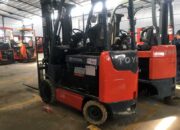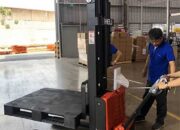Common Issues in Container Forklifts
Container forklifts are a crucial part of the cargo transportation and storage process, both at sea and in port yards. However, due to continuous operation and harsh working conditions, container forklifts often encounter various problems and damages. In this article, we will explore common issues in container forklifts and how to address them.
1. Mechanical Failures:
Lifting System Failure: One common issue is the inefficient operation or jamming of the lifting system during the container lifting process. This can be caused by issues in the hydraulic pump, lifting cylinder, control valves, or oil lines. To remedy this, regular inspection and maintenance of the lifting system are necessary.
Steering System Failure: Container forklifts can use either mechanical or electrical steering systems. Mechanical steering systems may fail due to aging or wear and tear, while electrical steering systems can face issues related to weak voltage or control system malfunctions. Inspect and replace faulty components to address this problem.
2. Electronic Control System Failures:
Electrical System Malfunction: Modern container forklifts rely on various electronic systems for control and monitoring. Malfunctions in the electronic systems can lead to significant issues. Causes may include circuit board malfunctions, sensor problems, or ineffective communication between devices. Use electronic testing equipment and computer programs to diagnose and repair malfunctions.
3. Structural Failures:
Rust and Corrosion: Due to their operation in maritime environments, container forklifts are often susceptible to rust and corrosion. Regular maintenance and repainting of the vehicle’s structure can prevent severe damage from rust.
Frame Damage: The frame of a container forklift can be damaged due to collisions, overloading, or aging. To address this issue, inspect and replace damaged parts, ensuring compliance with overloading regulations.
4. Tire Issues:
Tire Damage or Wear: Container forklift tires endure heavy loads and excessive wear and tear. Excessive damage or wear can lead to serious issues. Regularly check tire pressure and replace damaged or worn tires to ensure safety and optimal performance.
In all cases, regular maintenance and technical inspections play a crucial role in minimizing container forklift issues. Always follow the manufacturer’s guidelines and establish a routine maintenance schedule to ensure the smooth and safe operation of container forklifts.
How to Inspect and Address Common Container Forklift Issues
Inspecting and addressing issues with container forklifts is crucial to ensure their safety and performance. Below are guidelines on how to inspect and address some common issues with container forklifts:
1. Check the Lifting System:
The lifting system is a critical part of a container forklift. Inspect the lifting cylinders, hydraulic pumps, control valves, and oil lines to ensure they are functioning correctly. If you notice any signs of oil leakage, check the connections and the extent of the leakage, and replace damaged components. Inspect control valves and control units to ensure they operate accurately and safely.
2. Inspect the Steering System:
For mechanical steering systems, examine components such as the steering wheel, steering shaft, and connecting mechanisms. Ensure that they are not damaged or loose. For electrical steering systems, check the status of the electronic control system, sensors, and voltage. Ensure there are no errors in the electrical steering system.
3. Check the Electronic Systems:
Inspect the forklift’s electronic systems, including control panels, sensors, and communication systems. Use electronic testing equipment to identify and repair any technical issues or malfunctions within the electronic systems.
4. Inspect the Frame Structure:
Examine the structure of the container forklift for signs of rust or corrosion. If rust is present, schedule rust removal and repaint the structure to prevent further damage. Check the frame structure for any structural damage, and replace any damaged parts while adhering to overloading regulations.
5. Examine the Tires:
Regularly check the tires on the container forklift to ensure they have the correct pressure. Replace any tires that are damaged or excessively worn to prevent accidents and ensure safe operation.
In addition to the above guidelines, always perform routine maintenance following the manufacturer’s instructions and conduct safety inspections before using the container forklift. For severe or unexplained issues, seek assistance from a professional technician or specialized technical service to ensure the container forklift operates reliably and safely.
Samcovina Joint Stock Company: Your Trusted Partner for Container Forklift Maintenance
Samcovina Joint Stock Company is proud to be a leading provider of container forklift maintenance and service in Vietnam. We are committed to delivering high-quality services and effective solutions to ensure that your container forklifts operate reliably and safely.
Outstanding Expertise: Samcovina takes pride in having a team of highly skilled technicians with extensive experience in the field of container forklifts. We consistently update our knowledge and stay up-to-date with the latest technologies to efficiently handle any technical issues.
Comprehensive Services: We offer a wide range of maintenance and service options, including mechanical system checks, electronic system inspections, structural repairs, and tire replacements. Our team is always ready to meet any requirements, regardless of the size or type of container forklift.
Time and Cost Savings: Samcovina is committed to ensuring your container forklift operates optimally, helping you save time and resources. Regular maintenance and repairs can help you avoid costly repairs in the future.
Quality and Safety: Safety is our top priority. Samcovina ensures that your container forklift meets all safety standards and is always ready to operate safely and efficiently.
Allow Samcovina Joint Stock Company to become your reliable partner for container forklift maintenance. We are always ready to serve and ensure that your container forklifts operate smoothly, efficiently, and safely.







